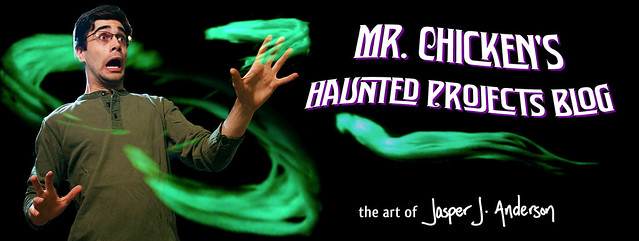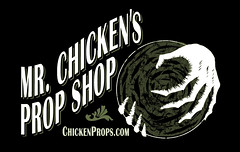Thoughts on Sculpting for a Haunt
Good evening. I'm Mr. Chicken, and you're entering my Hall of Illusions.
I was listening to the last two episodes while sculpting an old hag mask, and trying to figure out what to do another segment on for my return to the show, when suddenly I realized I was staring it in the face, quite literally. So pick up your sculpting tools and let’s talk about sculpture for haunting.
There’s a lot of information online about sculpture, so I want to focus on some ideas that you won’t hear as much. Specifically, these are the sculpting tips I wish someone had told me when I started out.
Types of clay:
There are basically four types of clay you want to know about for haunting. Air dry clay, oil-based clay, water-based clay, and oven-bake clay. Because each one behaves differently, I'm structuring this around them.
If you’re just starting out sculpting props, I recommend using air dry clay. I made most of my haunt characters’ heads out of Crayola Model Magic. It’s a really cheap air dry clay that has a bit of a learning curve for its quirks, but for making quick sculptures, it’s great. You won’t be able to get the kind of detail that even higher end air dry clays can give you, but it’s great for getting to understand what makes a cool sculpture. The big advantage of air dry clays for beginners is that your sculpture is your final product. You don’t need to mold and cast to get a usable prop. The main problem people experience with air dry clays is cracking. This happens because water is evaporating from the material, causing it to shrink. When the outside dries and therefore shrinks faster than the inside, you get cracking.
Oil-based clays are my favorite. I like to use a clay by Chavant called NSP Medium, which stands for “non-sulfur plastiline” with a medium hardness. I used to think even the soft was too hard, but here's the trick: You're not supposed to just start using the clay right out of the package. Oil based clays are meant to be heated so they soften to a comfortable consistency, then applied to your armature in the approximate form you're looking for. An easy way to do this is to line a box with aluminum foil to keep the oils from leeching out of the clay, and position a light bulb above it. Slice off smaller pieces of the clay and leave them in the box for a short while to soften up. When the clay cools down to the point where it's too stiff to easily work with your hands, you can either warm it up some more or move on to using your sculpting tools to work it into a more refined shape.
In water based clays, the one you want to look at is called WED (that's W E D). It was developed for Disney to sculpt the characters in the theme parks. WED differs from other water based clays in that it has added ingredients so it will take longer to dry out. The trick to WED is much like the Chavant. Right out of the package, WED clay is very soft and easy to pile onto your armature and squish around. It's nice to wear gloves at this stage so your hands don't get caked in clay muck. While you're playing with the forms, if you ever leave the sculpture, throw a plastic bag over it to keep it from drying out. You may even have to spritz it with a little water, but don't overdo it. When you're ready to add details, let the clay dry out a little. You're just looking for it to firm up, not get too dry and cracked. At this point, you can tool it much like an oil-based clay.
Note that both the water-based and oil-based clays are not suitable for a final prop. Whatever you sculpt in them will have to be molded and cast. Maybe I'll talk about that in a future episode.
Last is the oven-bake clay. Sculpey is the main brand. Honestly, it's not good for much in haunting because it's expensive and brittle. What it does well is make teeth. There are translucent colors available that, by themselves or mixed with white, can look very tooth-like pretty easily. Just take care not to introduce air bubbles in when you're shaping them, or you'll see a bunch of white spots inside after you bake.
I'll wrap it up there for this time. If you have any questions about this topic or suggestions for future segments, you can contact me directly at chickenhaunt [at] gmail.com.


No comments:
Post a Comment